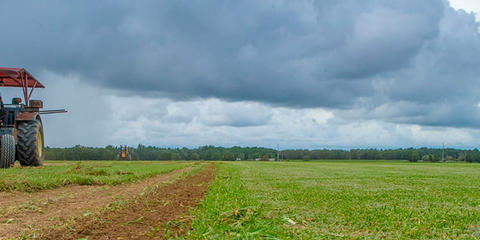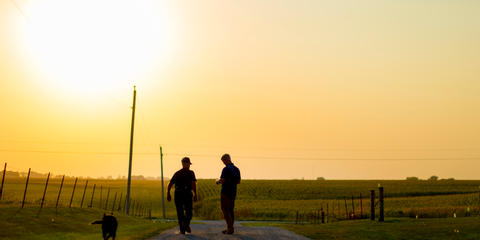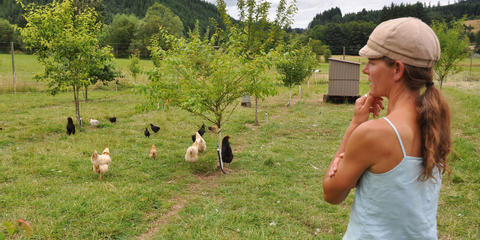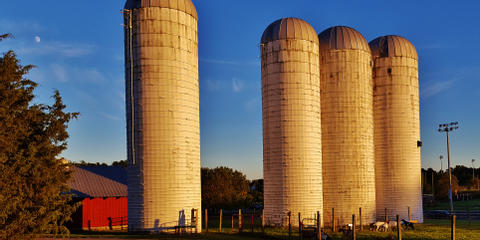
Coronavirus Food Assistance Program – Additional Assistance (CFAP-AA)
Closed April 4, 2021
USDA is providing additional assistance through the Coronavirus Food Assistance Program for certain agricultural producers whose operations were directly impacted by the coronavirus pandemic.
USDA announced the additional assistance on January 15, which includes expanding CFAP eligibility for some agricultural producers and commodities and updating payments to accurately compensate some producers who already applied for earlier assistance. This additional assistance builds on about $23.6 billion in payments made available through CFAP 1 and CFAP 2 earlier signups.
CFAP 1 and 2
USDA announced the first round of the Coronavirus Food Assistance Program, CFAP 1, on April 17, 2020. CFAP 1 provided direct relief to producers who faced price declines and additional marketing costs due to COVID-19. Learn more about CFAP 1 by visiting farmers.gov/cfap1.
USDA announced an expansion of the Coronavirus Food Assistance Program on September 17, 2020. Coronavirus Food Assistance Program 2, CFAP 2, provided producers with financial assistance to absorb some of the continued impacts of the COVID-19 pandemic.
Enterprises
Eligibility
Producers must be in the business of farming at the time of submitting their application to be eligible for CFAP additional assistance.
Producers can apply for assistance for only commercially produced commodities.
To be eligible for payments, a person or legal entity must have an average adjusted gross income of less than $900,000 for tax years 2016, 2017, and 2018. However, if 75 percent of their adjusted gross income comes from farming, ranching, or forestry-related activities, the AGI limit of $900,000 does not apply and the person or legal entity is eligible to receive CFAP payments up to the applicable payment limitation.
Persons and legal entities also must:
comply with the provisions of the “Highly Erodible Land and Wetland Conservation” regulations, often called the conservation compliance provisions; and
not have a controlled substance violation.
Additionally:
if a person is not a US Citizen or Resident Alien (possessing an I-551 “Green Card”), then that person must provide a significant contribution of capital, land, and active personal labor to be eligible for CFAP.
if a legal entity has more than 10 percent ownership held by persons who are not a US Citizen or Resident Alien, then that entity is eligible for payment only if each foreign person in the entity makes a significant contribution of labor to the farming operation. If the foreign person(s) does not make a significant contribution of active personal labor to the farming operation, the legal entity’s payment is reduced by the pro-rata ownership interest held by the foreign person(s).
Expanded Eligibility
In addition to producers previously eligible for CFAP 2, certain contract growers are now eligible to apply for CFAP 2, along with producers of pullets and turfgrass sod. Details are outlined by commodity, including more information on how to calculate payments and apply for the program.
Livestock by Contract Growers
Certain contract growers are now eligible for assistance through CFAP. Eligible producers must:
have raised broilers, pullets, layers, chicken eggs, turkeys, hogs, or pigs under a contract in 2019 and 2020.
demonstrate a drop in revenue for the period from January 1, 2020, through December 27, 2020, as compared to the period from January 1, 2019, through December 27, 2019.
provide a copy of their contract and documentation to support the information provided on their application, if requested by FSA.
Payments are based on eligible revenue for January 1, 2020, through December 27, 2020, minus eligible revenue for January 1, 2019, through December 27, 2019, multiplied by up to 80 percent.
Pullets
Pullet producers are now eligible for assistance through CFAP. This is one of several commodities that experienced COVID-19 market disruptions but had not been explicitly included in the initial CFAP 2 rule.
Payments for pullets will be equal to:
The amount of the producer’s eligible sales in calendar year 2019, multiplied by
The payment rate for that range.
Payments for producers who began farming in 2020 and had no sales in 2019 will be based on the producer’s actual 2020 sales as of the producer’s application date.
Example: A producer’s 2019 sales of pullets totaled $75,000. The payment is calculated as ($49,999 times 10.6%) plus ($25,001 times 9.9%) equals a total payment of $7,775.
Turfgrass Sod
Turfgrass sod producers are now eligible for assistance through CFAP. This is one of several commodities that experienced COVID-19 market disruptions but had not been explicitly included in the initial CFAP 2 rule.
Payments for turfgrass sod will be equal to:
The amount of the producer’s eligible sales in calendar year 2019, plus crop insurance indemnities, Noninsured Crop Disaster Assistance Program (NAP), and Wildfire and Hurricane Indemnity Program Plus (WHIP+) payments received for the 2019 crop year, multiplied by
The payment rate for that range.
Payments for producers who began farming in 2020 and had no sales in 2019 will be based on the producer’s actual 2020 sales as of the producer’s application date.
Example: A producer’s 2019 sales of eligible commodities and Noninsured Crop Disaster Assistance Program payments totaled $75,000. The payment is calculated as ($49,999 times 10.6%) plus ($25,001 times 9.9%) equals a total payment of $7,775.
Terms
The CFAP additional assistance includes changes to more accurately compensate producers who already applied for the program, and producers of certain commodities may be eligible for higher payments. Details are outlined by commodity, including new payment calculations and actions producers should take to update applications. No action is required for certain commodities.
The total CFAP payment that a person or legal entity may receive, directly or indirectly through attribution of payments, is $250,000. CFAP 1 and 2 are separate programs, and payment limits are unique for each program. This limitation applies to the total amount of CFAP 1 or CFAP 2 payments made with respect to all eligible commodities.
The total amount of CFAP 1 or CFAP 2 payments made to a legal entity – such as to a corporation, limited liability corporation, limited partnership, trust, or estate – is $250,000 except if:
two different members of the legal entity each provide at least 400 hours of active personal labor, active personal management, or combination thereof with respect to the production of 2020 commodities, then an entity may receive up to $500,000.
three different members of the legal entity each provide at least 400 hours of active personal labor, active personal management, or combination thereof with respect to the production of 2020 commodities, then an entity may receive up to $750,000.
Although the payment limitation is increased for the corporation, LLC, LP, trust, or estate, each members’ payment limitation (received directly or indirectly) remains subject to the $250,000 individual person payment limit.
These payment limit provisions are different from and separate from the payment limitations established by the 2018 Farm Bill.
Application Instructions
Producers who are modifying their applications should contact their local USDA Service Center for assistance. Producers who are filing new applications should contact their Service Center or call 877-508-8364 for one-on-one support. Additional information for those now eligible to apply for CFAP 2 or for eligible producers making CFAP 2 application modifications is available at farmers.gov/cfap2/apply.
Forms
CFAP Additional Assistance Application
Resources
Related Programs

Direct Farm Operating Loan
Farm Service Agency
- Loan
- General
- Equipment
- Animal Purchase
- Diversification
- Marketing
- Processing
- Feed
- Seed
- Fertilizer
- Cash Rent
- Housing
- Construction
- Infrastructure
- Repairs
- Pest Management
- Storage
- Legal & Finance
- Water Management
- Waterway Protection
- Water Quality
- Conservation
- Training
- Immigrants
- CSA
- Refinancing
- Reduced Tillage
- National
- Any

Environmental Quality Incentives Program (EQIP)
Natural Resources Conservation Service
- Grant
- Cost Share
- Conservation
- Cover Crops
- Forest Management
- Certified Grassfed
- Irrigation
- High Tunnel
- Certified Organic
- Air Quality
- Alternative Energy
- Soil Health
- Wildlife & Pollinator Habitat
- Water Quality
- Weather
- Research
- Landscape
- Precision Ag
- Drought
- Nutrient Management
- Carbon Capture
- Fencing
- Agroforestry
- Grazing Management
- Reduced Inputs
- National
- Any

Farm Storage Facility Loan Program (FSFL)
Farm Service Agency
- Loan
- Infrastructure
- Equipment
- Storage
- Lighting
- Delivery Vehicle
- National
- Oilseeds
- Peanuts
- Pulse Crops
- Hay
- Honey
- Biomass
- Fruits
- Vegetables
- Floriculture
- Hops
- Maple Sap
- Milk
- Cheese
- Yogurt
- Butter
- Eggs
- Rye
- Aquaculture
- Poultry
- Livestock
- Grains

Inflation Reduction Act Assistance for Distressed Borrowers
Farm Service Agency
- Grant
- Discount
- Socially Disadvantaged
- Disaster Relief
- National
- Any
Details
Release Date
January 19, 2021
Deadline
April 4, 2021
Organization
Financial Instrument
Grant
Maximum Award Amount
$750,000
Total Program Funding
$2,300,000,000
Updated October 8, 2021
Image Credit: USDA
This information was gathered from public sources. Ambrook is not responsible for or able to affect the results of any financial programs listed, nor are they responsible for any incorrect information that is listed or is on the hyperlinked external sites. All information is subject to change.
Explore hundreds more programs on Ambrook.